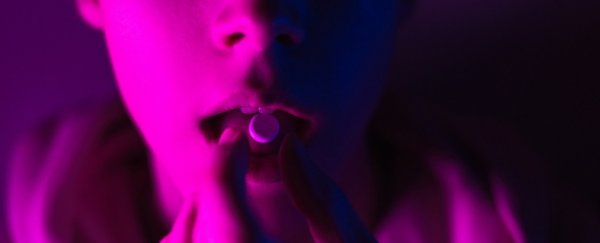Psychedelic users have long celebrated the therapeutic properties of LSD, especially for pain, and now, after decades of being banned from clinical trials, scientists are finally revisiting the drug and putting it to the test.
A randomized double-blind study has now found small amounts of LSD can reduce the perception of pain significantly more than a placebo.
With just three non-hallucinogenic "micro"doses, participants displayed what seemed to be an increase in pain tolerance and a decrease in subjective perceptions of pain. This prolonged response, the authors claim, is on par with up to 20 mg of oxycodone or morphine.
The size of the dosage, however, did matter. Any amount of LSD lower than 20 µg (which is considered a relatively large microdose among online users) did not seem to have this reported analgesic effect.
"The present data suggest that low doses of LSD might constitute a novel pharmacological therapy that can be efficacious in patients and is devoid of problematic sequelae that are associated with current mainstay drugs, such as opioids," the authors conclude.
The analgesic effects of LSD were tested on 24 healthy participants, who were randomly either given a dose of the drug - 5 µg, 10 µg or 20 µg - or a dose of placebo.
At several points throughout the day, participants were then asked to place their hand in a tank of cold water for as long as possible, until they couldn't take it anymore, at which point, they could pull their hand out.
If a participant lasted for three minutes, they were asked to stop by the experimenter.
Blood samples and subjective ratings of painfulness, unpleasantness, and stress were then assessed by researchers.
The experiment was then repeated on four separate days with several days in between to 'wash out' any carry-over effects.
Obviously this is a small trial. But a 20 µg dose of LSD increased immersion time by about 20 percent, and was found to be equally strong five hours after taking the drug as it was 1.5 hours after taking the drug.
This suggests the pharmacological effects of LSD can last for many hours even with small doses. The analgesic effects may even go longer than the five-hour length of the current experiment, but they didn't test it beyond that.
"The reduction in subjective pain perception is remarkable," the authors write, "because it was measurable despite a prolonged exposure time to the pain stimulus in LSD 20 µg treatment condition."
It's still unclear why participants were able to tolerate pain for a longer period of time, but some suspect LSD causes psychological changes that might help us cope with discomfort by taking our minds off the sensation.
Others think it might have something to do with self-transcendence, kind of like meditation - in essence, the authors say, this idea boils down to: "no self, no pain".
In vivo studies on rats have shown LSD has an impact on serotonin receptors, which is a major contributor to the sensation of pain, yet human research has lagged behind because of strict regulations in the past.
More research is needed to figure out how LSD alters our consciousness and perceptions of the world around us, but this phase I clinical trial suggests the right dosage could very well have therapeutic effects for those in acute or even chronic pain.
"The study revealed the minimal dose at which analgesic activity of LSD is effective," the authors explain.
"Yet, an extended dose-finding study is needed to determine the dose at which analgesic effects of LSD are optimal, i.e. when efficacy is maximal and mental interference is minimal."
That's one of the issues with LSD at the moment. While this classic hallucinogen could potentially hold therapeutic benefits, it's not useful as a form of medicine if it's going to cause 'bad trips', paranoia or distress.
Microdosing looks like a promising way to ensure a more positive experience for patients, but another approach researchers are looking into is 'candyflipping'.
This is the colloquial term for mixing LSD and MDMA to create a psychological state that is more pleasant and has longer-lasting effects.
The internet is full of anecdotal evidence that suggests this combination really does work, but the practice has never been properly scrutinised by scientists - a newly announced clinical trial run by Mind Medicine Inc and the University of Basel in Switzerland aims to do just that.
"With this innovative treatment paradigm, we are looking to bring the participants outside the bounds of their everyday perceptions, bringing their mind into a very flexible state of mind facilitating new states of consciousness," said president of Mind Medicine Miri Halperin Wernli in a statement.
"This will provide the opportunity to step outside their usual sense of self and experience themselves from a radically different and new perspective."
Now that regulations have been lifted, research and clinical trials on psychedelics are moving fast, and the therapeutic results so far obtained from psilocybin, LSD, and MDMA studies look incredibly promising for a whole variety of issues, from depression to anxiety to PTSD to pain.
The research has been published in The Journal of Psychopharmacology.
